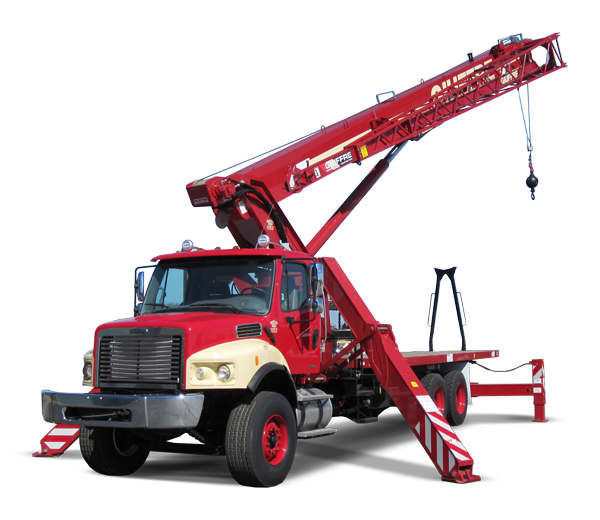- Home
- About Giuffre
- Selecting the Right Boom Truck
Selecting the Right Boom Truck
CRANES INC.
Selecting the Right Boom Truck
the boom truck buyers guide
Take out the guess work
With an almost endless list of available options and configurations, selecting the right boom truck for your crew can seem like an overwhelming challenge.
To help you, we’ve put together this introductory guide with the most important factors you should consider during your decision making process. As you read through this guide, don’t hesitate to give us a call – we’re here to help answer any questions you may have.
Know Capacity and Boom Needs
Do Your Homework
Taking into consideration the lift requirements of your past and most frequent types of projects will quickly help you determine ideal lift capacity and boom length requirements.
You’ll want to purchase a boom truck that can handle 90% of your projects. The rest of the time, you’ll want to simply rent a larger capacity crane. This will ensure you’re getting the biggest return on investment, and will reduce the size of crane you need to purchase.
.
Single vs. Tandem Axel Trucks
Again, take a look at your most common types of projects. If you’re commonly working on residential projects that require driveway approach, you’ll want to consider a single-axel truck.
Single Axle Truck
With a lighter gross weight and shorter wheel base, you’ll be reducing the likelihood of causing costly property damage.
Tandem Axle Truck
If you’re more commonly working on commercial projects, or projects that require a larger lifting capacity, you’ll want to consider a tandem-axel truck. Tandem axels increase the truck’s hauling power and accommodate larger capacity cranes.
More feet on the ground
Adding a Front Stabilizer
A cost-effective way of increasing your crane’s versatility, plus add the following benefits:
- Add's full 360° area of operation to most cranes
- Increase overall stability
- Distribute total truck weight over 5 points
- Ability to lift over cab of truck
Maintenance records = gold
Buying New, Used, or Rental?
Most large crane dealers will have an internal rental department from which they will often sell units that have been rented out.
This will sometimes scare buyers, into believing the equipment has been abused or neglected, when quite the opposite is usually true! Many private companies do not have a service department, or the qualified staff on hand to perform thorough inspections, and frequently grease hard to reach or hidden grease points. This hidden danger can then be passed on to the new owner without ever being seen.
A reputable crane dealer will inspect a crane pre and post rental to ensure their equipment is in good working order, and to help limit injury or damages. Crane dealers will also keep maintenance records on file for the prospective buyer to see.
add height, not reach
Adding a Jib (Stinger)
Adding a Jib to your crane is an easy way to add versatility to you boom truck. With an installed Jib, you get extra boom length when you need it, and it’s out of the way when you don’t. Keep in mind, however, that having a jib will add weight to the crane’s boom when stowed, and will slightly decrease the crane’s lifting capacity.
Side folding Jib
- Jib pins to boom tip, and is swung out when needed
- Can also include a pull-out, or "stinger" section for additional length
- Can add a significant amount of height to your crane
- Reduced capacity when lifting from jib
Lattice Jib
- Reduced weight, increased strength vs conventional "box boom" construction
- Sometimes includes a standard "box boom" pull-out section for additional length
- Lattice work jibs usually cost more money than conventional jibs
Offset Jib
- Adjustable mounting configuration - allows downward "tilt" in relation to the main boom
- When lifting with high boom-angle, negative off-set allows for increased radius
- Negative offset can allow crane to "reach over" the roof line for maximum versatility.
- Typically only available with lattice style jib construction.
the boom truck buyers guide
Boom Mounting Options
Crane booms are available in standard and rear mount configurations. There are advantages and disadvantages to both.
Standard Mount Boom Crane (SM)
- Boom is located directly behind the truck’s cab
- Most common boom truck configuration
- Most cost effective
- Provides increased bed-space for storing product
Rear Mount Boom Cranes (RM)
- Boom is located at the back of the truck bed
- Allows crane operator to get closer to work area
- Requires more bed space and reduces the amount of product storage space
- Many reduce the truck's hauling capacity
Rear Mounted (Rider Seat) Boom Crane (RS)
- Boom is located at the back of truck bed
- Can include an optional enclosed cab
- Increases comfort and allows operator to rotate with boom
- Operator is positioned in a sitting position, rather than on the ground
- Provides a 360-Degree working area
- More expensive
Bigger isn't always better
Short vs. Long Boom Lengths
Selecting the correct boom length can make your crane the most useful for the desired type of work.
Short Booms
- Lighter and easier to operate
- Requires a smaller outrigger footprint
- Ideal for tight working conditions and lighter lift requirement projects
Long Booms
- Increased crane reach and height, but at a reduced lifting capacity
Crane + high-reach manlift
Adding a Man Basket
Adding a man-basket option to your boom truck is essential for almost all truck owners. With the optional man-basket, you’ll instantly increase your truck’s capabilities and reduce the need to rent portable man-lifts for your projects.













